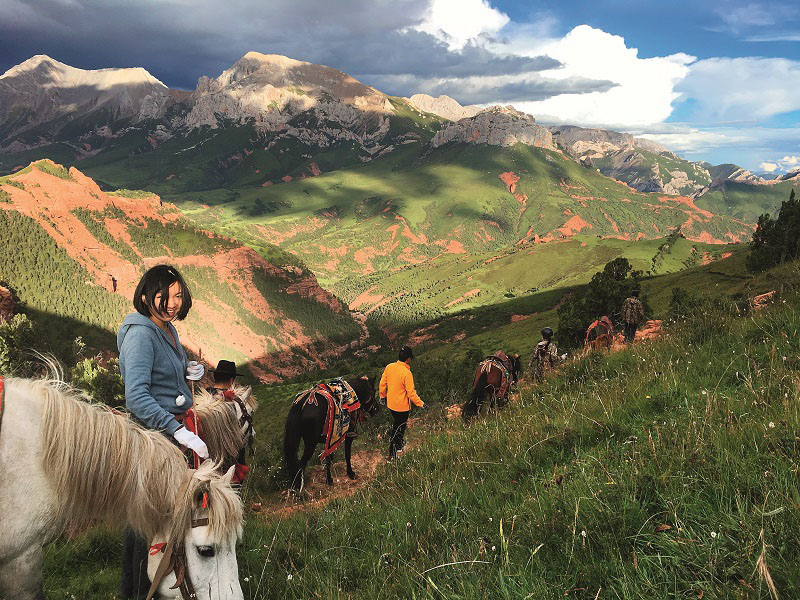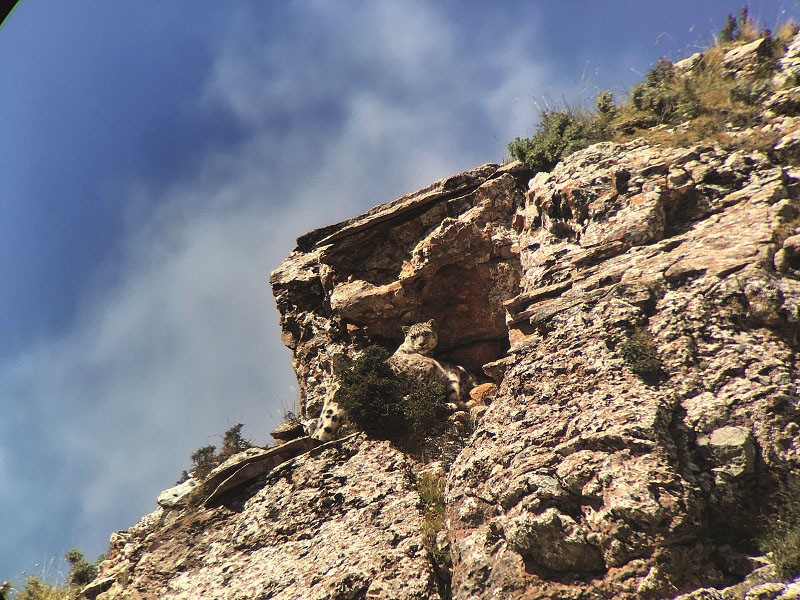From Sanjiangyuan to Global Biodiversity Protection

“Snow leopard!” I blurted out to my friends Zhang Chengxin and Liu Garbo, attempting a whisper that betrayed my excitement. Bolting upright, they hurried over and stood erect on the grassy mountainside 4,000 meters above sea level. Their faces lit up as, in turn, they looked through my telescope to set eyes on this most elusive and mysterious of the big cats. We couldn’t believe our luck. There we were, in a valley along the upper reaches of the Lancang River, watching the “grey ghost,” one of the most difficult-to-see mammals in the world—the snow leopard.

Stewarding the Source of Three Rivers
This magical experience happened on the Qinghai-Tibet Plateau, one of China’s great wildernesses known as “the roof of the world.” In addition to being home to unique plants, birds, insects and reptiles, this vast area hosts a higher density of apex predator species than anywhere else in the world. With an abundance of luck and patience, one can encounter the common leopard, lynx, wolf, brown bear, and the jewel in the crown—the snow leopard.
It is no surprise that China’s first national park was created here.
The Sanjiangyuan (literally “the source of three rivers”) National Park covers an area comparable to the size of England. And, as its Chinese name suggests, in addition to the incredible biodiversity and spectacular scenery, the park is also the origin of China’s three great rivers—the Lancang, the Yellow, and the mighty Yangtze. Together, they provide fresh water for over a billion people and irrigate China’s agricultural heartland.
Residents of Sanjiangyuan include more than wildlife. The people that have lived in the area for generations—mostly Tibetan herders—have a deep respect for the environment grounded in both their religious beliefs and an understanding that they directly depend on a healthy environment for their living.
Long-term success in conservation depends on active support and participation from local people. At the first forum on national parks in 2019 in Xining, capital of northwestern China’s Qinghai Province, Jonathan Jarvis, former director of the U.S. National Park Service, said that the biggest lesson from the U.S. experience was to value the knowledge of the local people. They know their homeland inside out. Their understanding of the environment and its wild inhabitants makes them ideally placed to take on roles such as rangers and guides in national parks.
That is why investing in local communities is so important.

Following that fortunate encounter with snow leopards in 2016, it has been the privilege of my life to work with Shan Shui Conservation Center, a Chinese non-governmental organization (NGO) founded by Professor Lyu Zhi of Peking University, and the local government in Qinghai on organizing the first community-based wildlife-watching project inside the Sanjiangyuan National Park in China—known as the “Valley of the Cats.” The project enables a limited number of tourists to visit the area, stay with local families, and be guided by them to look for special wildlife. Importantly, 100 percent of the revenue stays in the local community. It is a way to generate income for the local people in recognition of their role in stewarding this special place for the benefit of the whole population.
China in Action
The creation of the Sanjiangyuan National Park, one of the first five national parks formally announced by the Chinese government, is indicative of the progress on biodiversity conservation in China over the last decade.
Starting from the top, Chinese President Xi Jinping has promoted the concept of “eco-civilization,” acknowledging that a healthy economy is dependent on a healthy environment. And underneath this top-level rhetoric, a series of legislative and policy initiatives have strengthened protection of China’s natural heritage.
China’s Wildlife Protection Law and Environmental Protection Law have been tightened to include stiff penalties for anyone found harming wildlife and key habitats or polluting the air, water, or soil. The list of specially protected species has been revised and updated and now includes not only megafauna such as giant pandas and tigers but also a raft of less-known animals including birds such as the critically endangered yellow-breasted bunting and many plants.
A decade ago, China’s coastal wetlands, at the heart of a major migratory bird route called the East Asian-Australasian Flyway, were being lost at a rapid pace, putting the future of many shorebird species in jeopardy. In 2014, the Chinese government announced a ban on reclamation of these important sites and began a process to protect those that remained. In 2019, Yancheng in Jiangsu Province became part of the first group of important wetlands inscribed as a World Heritage site.
At the same time, China has implemented its innovative “ecological red line” policy that ensures the protection of key ecosystems across the country, set targets for the recovery of coastal mangroves, and launched vital initiatives to protect and restore major rivers including a 10-year fishing ban along the Yangtze River.
China’s action has been the foundation for the country to take on the presidency of the UN Convention on Biological Diversity in 2021. Over the last few years, China worked with more than 190 countries to reach an agreement on a new Global Biodiversity Framework at COP15 in Montreal in December 2022.
Globally, experts estimate that the populations of vertebrates have declined by an average of 69 percent since 1970 and that the extinction rate of species could be as high as 1,000 times the natural rate. This staggering loss of biodiversity—all in the blink of an eye in evolutionary terms—is not just tragic as we lose species forever; we are also beginning to understand the incredible risks to humans.
Turning around the current trajectory will require a monumental effort from governments, businesses, communities, and citizens around the world. The aim must be to align all activities with the goals of the new Kunming-Montreal Global Biodiversity Framework. The biodiversity crisis and the inextricably linked climate crisis are the challenges of our generation. However, big or small, we can all do something to help, and the actions in China over recent
years should inspire hope.